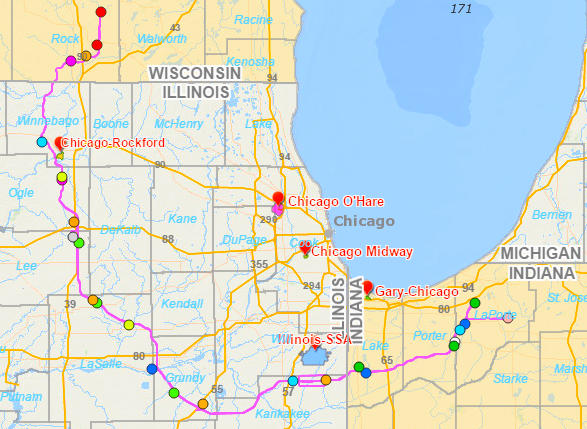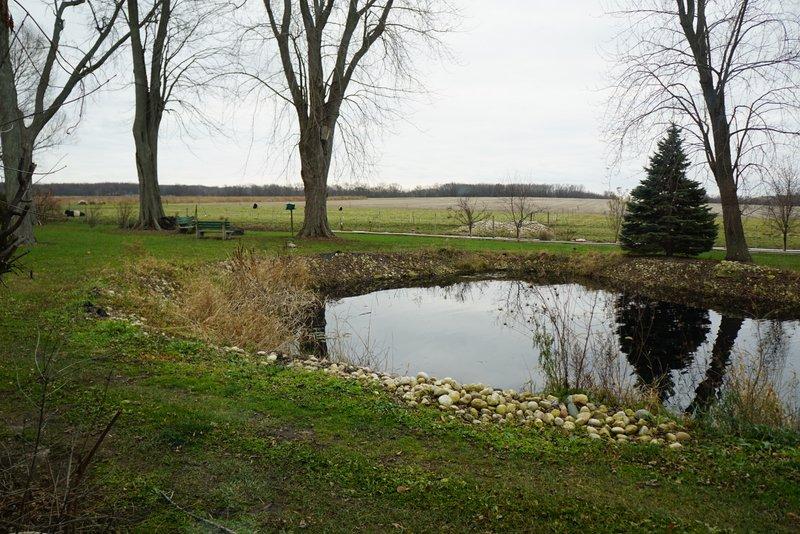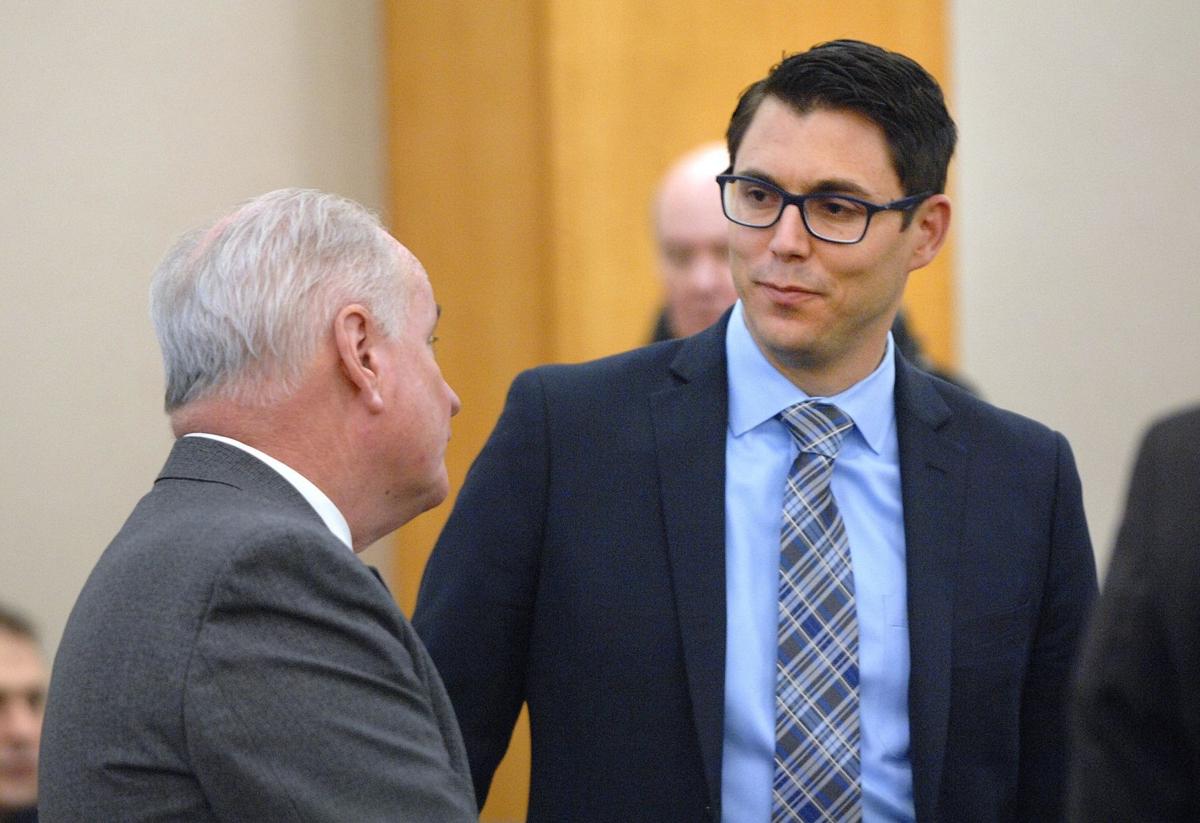If you wish to actually listen to the story click on the reference given at the end of each story and and click on the”sound” symbol.
Lack of Information Leaves Rockford Area Ambivalent About GLBR Economic Benefits
By Chase Cavanaugh • 4 hours ago
TweetShareGoogle+Email
One of the main arguments Great Lakes Basin Transportation Inc. has made in favor of its rail project is that it would act as an economic driver for the region. Company lawyer Mike Blaszak says construction would create a significant number of jobs.
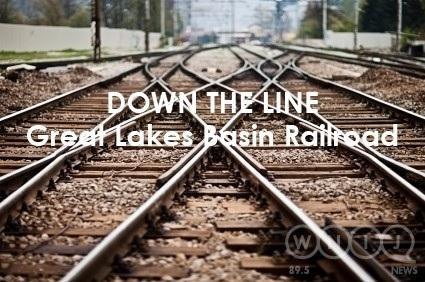
"Those of course, would be temporary," he said, "but the construction period would last at least two years."
Once the railroad is in operation, he envisions a smaller set of permanent positions operating trains, maintaining track, and other daily functions.
"I’m not trying to set a bar here for what we ought to pay somebody, but railroad people typically make in the upper five figures," he said. "We think that’s going to be an attractive option for people in the community who might be looking for employment."
As for the route's customers, Blaszak claims various companies have reached out, with a "substantial amount of interest" expressed in confidential meetings.
A Planning Agency's Tentative Support
One of the groups which first examined the project was the Rockford Metropolitan Agency for Planning, or RMAP. Per federal law, it plans and coordinates decisions regarding the region's current and future transportation networks. In keeping with its name, RMAP works with Loves Park, Machesney Park, Belvidere, and Winnebago and Boone Counties as well as Rockford.
Executive Director Michael Dunn says their involvement with GLBR began early.

Michael Dunn is the Executive Director of the Rockford Metropolitan Agency For Planning.
Credit RMAP
“My predecessor, Steve Ernst, was the one who was mostly involved in the Great Lakes Basin Railroad project. He had been working with the leaders of that project for the last three or four years.”
After examining the initial concept, Dunn says RMAP envisioned two potential benefits that GLBR could bring to Rockford-area freight transport.
“There’s a linkage that is defunct between the Rockford airport and Rochelle that would be supplemented by the Great Lakes Basin Railroad and allow more throughput between the two communities. Another benefit, if this happens, would be that traffic would be able to bypass the city of Rockford and not have to come through the central city.”
Dunn believes diverting these shipments could allow the area to modernize the Canadian National rail yards and put them closer to Chicago Rockford International Airport.
These advantages intrigued the RMAP board, which is made up of elected officials from the representative cities and counties. In their June meeting, six members voted in favor of a letter endorsing the project, and sent it to the federal Surface Transportation Board.
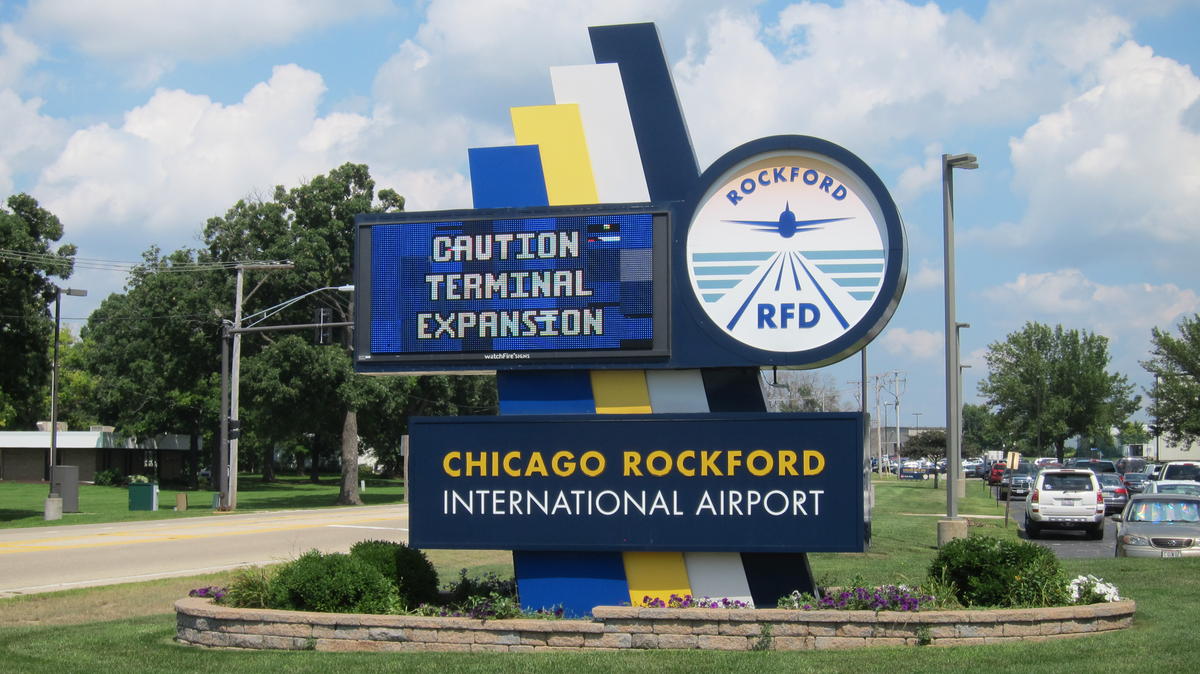
RMAP believes the railroad could benefit freight transit through closer linkage to the airport.
Credit Chase Cavanaugh/WNIJ
However, one member of the body abstained, and Dunn says the letter doesn’t represent complete support.
“That board did want to support this concept," he said, "but they withheld support for any specific route because we want to make sure that the routes are in conformance with the county comprehensive plan, RMAP’s plan, and all that.”
RMAP has a detailed greenways plan that maps environmentally sensitive areas throughout Winnebago and Boone Counties. In their letter, the board noted they "do not have enough information from GLBRR to fully understand how the current route will affect the existing transportation, agricultural land use, and environmental asset-mapping plans for the region."
Local Business Groups Say It's Too Early
Despite GLBR's claims of "significant interest," other business groups have their own reservations. Mike Nicholas of the Rockford Area Economic Development Council said he is trying to get GLBR founder and managing partner Frank Patton to speak with them so they can have a "better understanding of his plans." The Rockford Chamber of Commerce said they didn't have a position on the railroad.
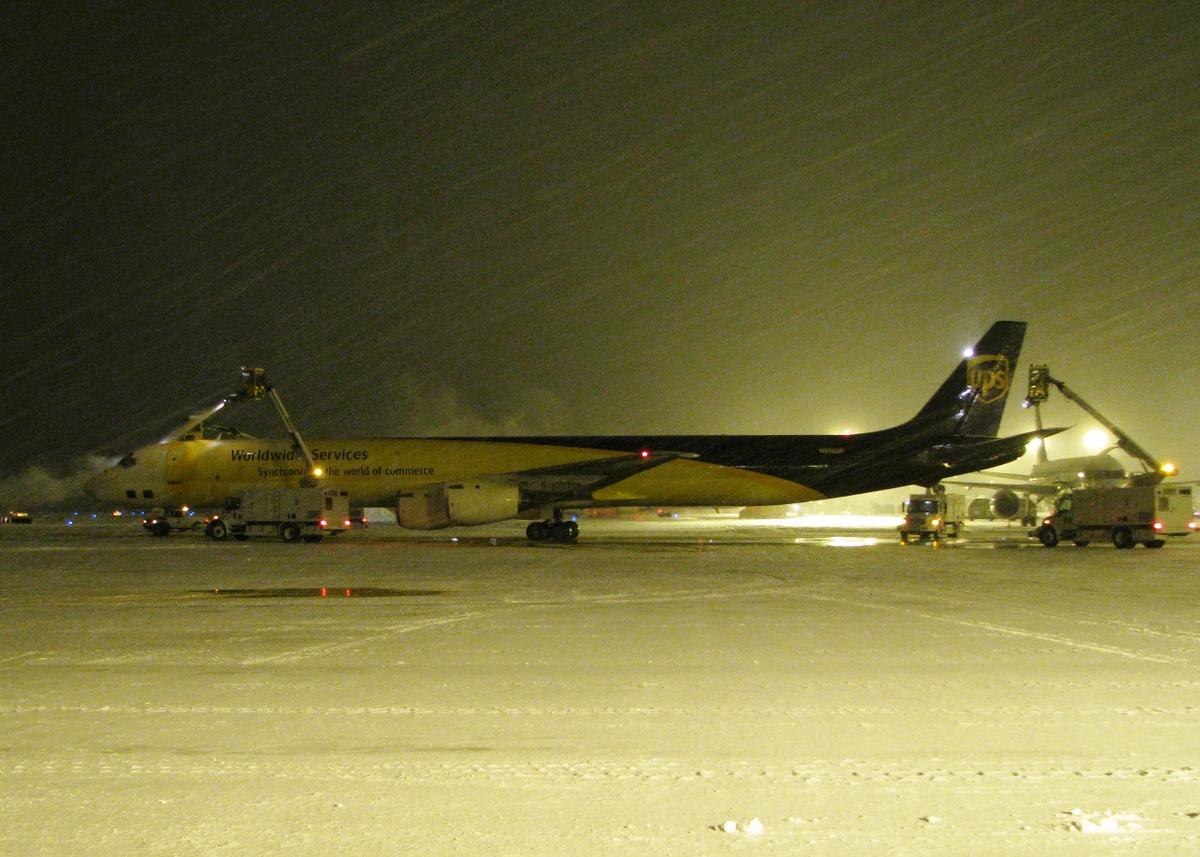
A UPS airliner being de-iced at Chicago Rockford International Airport. UPS has its second largest shipping hub here.
Credit Chicago Rockford International Airport
Shipping company UPS has its second-largest hub at Rockford’s airport and could potentially benefit from the increased freight traffic. However, spokesman Dan McMackin said the line is not something they've studied. He says one of their transportation managers would meet with GLBR next year, but it was too early to disclose anything.
What Comes Next
Ultimately, the final path of the railroad will be determined by the Surface Transportation Board's environmental impact statement. Dunn says before this happens, everyone needs more information.
“Until there’s public participation on the routes, until routes are narrowed down, nobody’s going to spend the money to bring in-the-field research on whatever the final route might be," he says. "Even then, the research might show that there’s some issues, and they’re gonna have to go back and refine again. It’s a very long process.”
Great Lakes Basin founder Frank Patton recently filed a request to put the environmental impact review on hold. Blaszak says that will allow them to provide more comprehensive information on the railroad’s business and operating impact. Their request was granted December 13, but the Surface Transportation Board expects a progress report by Feburary 28.
Great Lakes Basin can’t begin any construction until the STB makes a final ruling -- and that could still take years, even after the review process resumes.
Above is from: http://northernpublicradio.org/post/lack-information-leaves-rockford-area-ambivalent-about-glbr-economic-benefits
Farmers Along The Latest GLBR Route Fear The Effect On Their Livelihood
By Susan Stephens • Dec 15, 2016
TweetShareGoogle+Email
Meet some of the people whose lives could change because of the GLBR
Over the past year, through three iterations of route proposals, many landowners were outraged when they learned their homes and farms were in the path of a railroad that would divert freight traffic around the Chicago area. They took that anger to a series of sometimes raucous public hearings.

But it’s easy to lose sight of the individuals in a crowd. This isn’t just a gang of rabble-rousers; these are real people. So we met with opponents of the Great Lakes Basin Railroad on their own turf: turf that the rail company would like to sink its tracks into.
Kathi Jurkowski calls her herd to dinner. And it really is a herd -- of chunky, shaggy, skittish two-toned cattle. She raises these Scottish purebreds on her farm and home, Klover Korners in Rockton. They’re Belted Galloways, also known as “Oreo Cookie Cows” because of the white band around their middles.
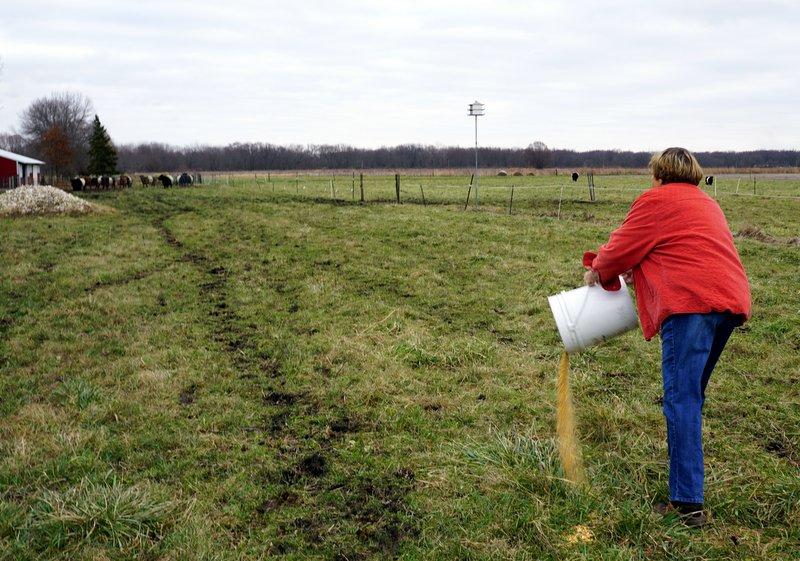
Kathi Jurkowski lures her Belted Galloway herd with a bucket of bovine snacks.
Credit Susan Stephens / WNIJ
As she delivers an afternoon snack of a bucket of grain, Jurkowski points across the pasture. “So, see where that tree line is? That’s where my grandkids live," she says. "And that’s where the tracks will be. So I won’t be able to see them. We’ll just be able to wave at each other between the train cars.”
Her son bought the neighboring farm so his children could be close to their grandparents -- and the hunting was good.
Kathi and Jerry Jurkowski built their brick house 30 years ago in rural northern Winnebago County, not far from the Wisconsin border. They have 200 acres, with plenty of room for their Belted Galloways, goats, and chickens, as well as the corn and soybeans they grow to help pay the bills. It’s where they plan to spend the rest of their lives. Then, in September, they learned the Great Lakes Basin Railroad had changed its route. Trains would pass closer than 200 feet from their bedroom. Jerry Jurkowski says it goes beyond just the loss of part of their land. What happens to the remaining land is one of the reasons a number of county farm bureaus, such as Winnebago-Boone, oppose the rail line.

A Belted Galloway stands its ground in the pasture at Klover Korners in Rockton.
Credit Susan Stephens / WNIJ
“It makes many odd-shaped fields that are very, very difficult to work,” he says. “A triangle is probably one of the worst things to farm. And it’s making many, many triangles across the state.”
Within a few months of learning about the rail line, the Jurkowskis found themselves becoming experts in all things rail. Neighbors started meeting in their home to plan their opposition strategy. They’ve been outspoken opponents at public hearings. They’re active on anti-Great Lakes Basin Railroad social media sites. They’ve become a clearinghouse for yard signs.

Jerry and Kathi Jurkowski in their Rockton-area home with Bunny the Dog
Credit Susan Stephens / WNIJ
And Kathi has put together a presentation to take to area clubs and organizations. She says people throughout the region are learning they have something in common. “When you start over in LaPorte, Indiana, this is thousands and thousands of acres of pristine farmland," she says. "And they talk about creating jobs? What about the jobs they are taking away? Farmers hire people. Farming is a job.”
Then Jurkowski jokes this has been a heck of a way to make new friends.
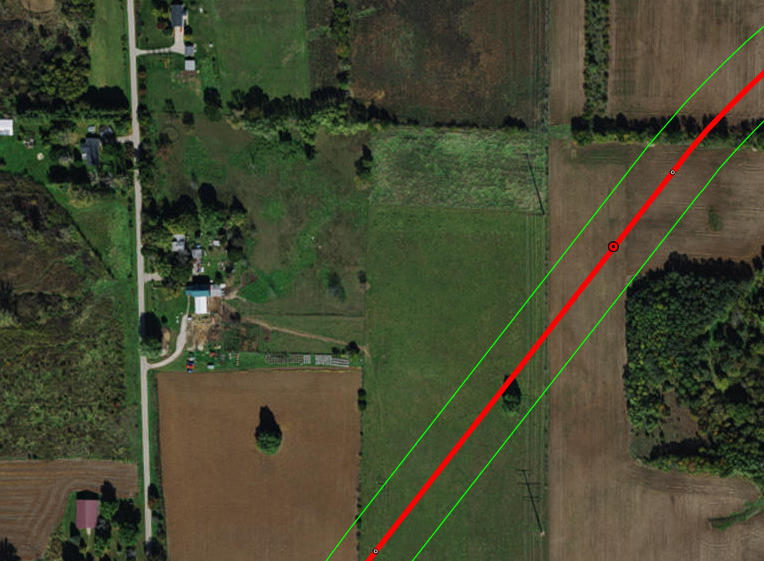
A satellite map from the GLBT website shows how close the proposed rail line would come to the Double-B Farm, which can be seen on the left side of the map, near Beloit, Wis.
Credit GLBT / greatlakesbasin.net
About ten miles north of the Jurkowski farm, across the Wisconsin state line, is one of the area’s busiest best-kept secrets: Double-B Farm, Country Store, and Café.
Jim Lyga calls it “the most unique place I’ve ever found.” He’s a retired photographer who has parked himself in a busy part of the restaurant regulars call “The Room of Knowledge.” He says he shows up every day for coffee. Thursdays are special because his crew gets together to solve the world’s problems. They call themselves the ROTC: The Retired Old-Timers Club. Club members tend to have strong opinions on everything. They’re unanimous in their stance against the Great Lakes Basin Railroad.

Some of the regulars at Double-B Cafe in Beloit share conversation as they wait for refills.
Credit Susan Stephens / WNIJ
Joe Weum says, “It’s kind of like Standing Rock. They think they have less opposition so they can just bulldoze over us.” He lives about three miles from the proposed path but doesn’t want to deal with construction tie-ups and the fear of cars loaded with hazardous waste derailing. Retired Rock County Sheriff Howard Erickson says he doesn’t know anyone in Beloit Township who supports the plan.
Retired Old-Timers Club members treat the Double-B like home -- or better. They take turns refilling coffee cups for all of the customers. They even pooled their money to fix the driveway when it needed repair. They’ve looked at the maps and know the current proposed path of the train line is a threat to their gathering spot. The two-room restaurant is located in the front part of a barn built in 1850. Baby farm animals live in the back part of the barn, ‘til they’re old enough to move outside.
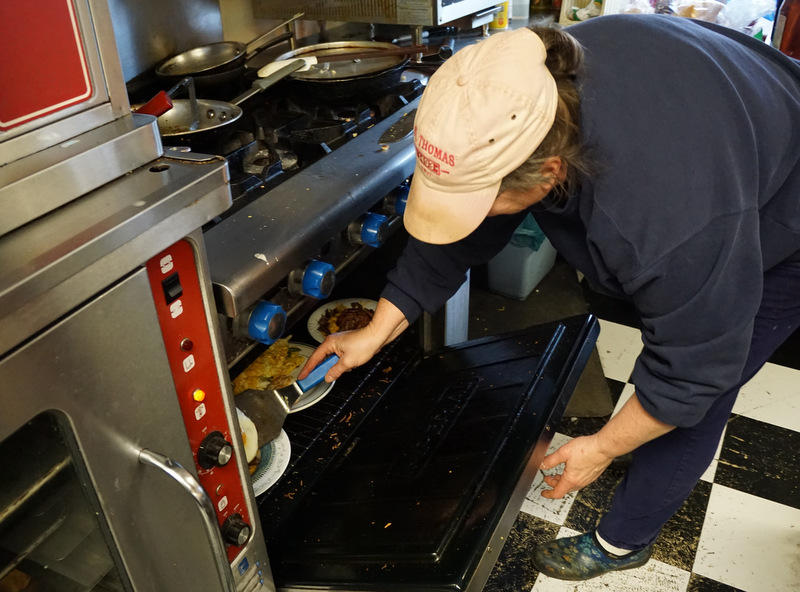
Barb Beeler does all of the cooking at her Double-B restaurant.
Credit Susan Stephens / WNIJ
This is Barb Beeler’s farm. Once she’s finished feeding her restaurant customers, it’s time to take care of the hungry crowd outside.
These are the cattle, sheep, pigs, and chickens that end up on her customers’ plates. She says the current path of the rail cuts off her house, barn, and restaurant from her pasture – the food source for many of her animals.
“So everything we have on the 43 acres is on the other side of the train,” Beeler says as she feeds the pen full of goats – and one sheep. “So when you pull into this lot, you see tracks. If it went up to the top and went straight by the power poles, wouldn’t affect us as much. But this is cutting us out of pasture land.”

The population at Double-B farm near Beloit is more than just people and "Oreo Cookie Cows."
Credit Susan Stephens / WNIJ
Beeler isn’t sure if she and her husband can afford to keep their livestock if a rail runs between them and their grazing land. And it’s the farm-raised meat that keeps their restaurant viable. She also isn’t sure the limestone foundation of her sesquicentennial barn can handle the vibration of a train running less than a football field away. Like many other farmers along the route, she feels disrespected by the whole process. Great Lakes Basin Transportation maintains the path was drawn to have the “least impact” on people.
Beeler takes issue with that: “We are still people. We are not packed together, but we are still people. We count," she says. "Don’t call us a wasteland. You can’t make more ag land. Once you take it away, that’s it. It’s done.”
Like others who have protested in meetings and comments submitted to the federal agency in charge of approving rail projects, Beeler says she is living in limbo. “Do I have to sit for two years and wonder, ‘Am I gonna have a train in my yard?’”
The wait probably will be that long. Building a railroad from scratch is a long process. Frank Patton, the founder and chairman of Great Lakes Basin Transportation, says America has forgotten how to build railroads. And, at this point, it’s in the hands of the Surface Transportation Board.
“It’s a new day, it’s a new process,” Patton said after a public meeting in Grundy County, “We will obey the law and follow the permitting processes. We want everyone to stay informed as we move forward. We want to talk to every property owner eventually, but it’s too early now. But within a year or two. There are some terrific ideas coming in through our website, and it just shows there’s no monopoly on wisdom.”
So, while the wheels of bureaucracy turn slowly along the tracks in Washington, opponents of the Great Lakes Basin Railroad are encouraging each other to continue their fight. That means telling their story to whomever will listen and keeping the comments flowing to the Surface Transportation Board.
Above is from: http://northernpublicradio.org/post/farmers-along-latest-glbr-route-fear-effect-their-livelihood
The GLBR From Start To Nowhere Near Finish
By Susan Stephens • Dec 15, 2016
TweetShareGoogle+Email
What’s the Great Lakes Basin Railroad and why should I care?
The GLBR is a proposed railway that, if you live in northern Illinois, southern Wisconsin, or northwest Indiana, you’ve either never heard of or have spent a lot of time learning about over the last year.

Under the current route proposal, the Great Lakes Basin Railroad would enter Kankakee County, Illinois, just below the Will County line, traveling west-southwest to enter Grundy County a couple of miles above its southern boundary.
The route then angles northwest and enters LaSalle County at roughly the southern border of Kendall County, heading northwest into Lee County about two miles west of the DeKalb County line. It goes north to parallel Interstate 39 to just north of Rochelle in Ogle County, where it jogs west and heads up into Winnebago County just west of the Chicago Rockford International Airport.
The route then meanders through western Winnebago County into Rock County, Wisconsin, less than 10 miles west of Beloit. It crosses Interstate 90/39 a few miles north of Beloit and then heads north to a point east of Milton where it would join the Wisconsin and Southern Railroad, which provides connections to Milwaukee.

Examining maps of the proposed railroad in Morris, IL, May, 2016
Credit Susan Stephens / WNIJ
Simply put, it’s a big ring around the Chicago area, way outside Chicago. There would be a 15-thousand acre rail port near Manteno, not far from the proposed “Third Chicago Airport” in Peotone. The reason this rail runs so far out beyond the Chicago suburbs is to avoid the traffic. That’s the point. The Great Lakes Basin Railroad would route traffic around Chicago-area congestion while creating connections for other railroads that want to move faster within the region. This is not about commuter rail.
Who’s behind it?
It’s the brainchild -- and dream -- of Frank Patton. He lives in Will County, is a former computer programmer, and founded a software company serving the financial industry. The Great Lakes Basin railroad started as an idea to run a toll railway along the proposed Illiana Expressway, which was supposed to relieve highway congestion. The Illiana was eventually tabled, and Patton started looking at other ways to relieve rail back-ups in Chicago. He founded Great Lakes Basin Transportation five years ago and partnered with Jim Wilson, who has experience in operations for Santa Fe Railroad. What they’ve come up with is a 260 mile, $8 billion project. They want to reduce freight rail travel time in the Chicago area from 30 hours to 8. Frank Patton says “This is a plan that according to people who understand the process, and what could end up after it’s built, could have a huge impact on the economy of region, on successive generations.”
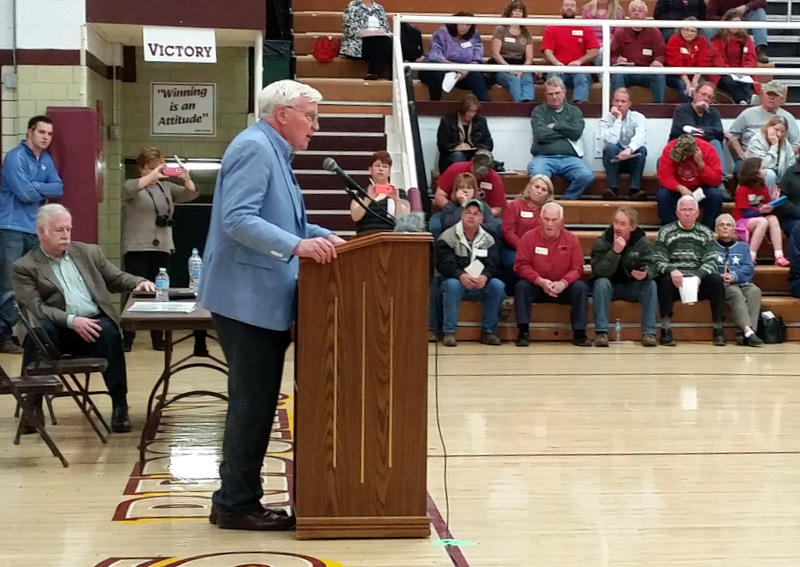
Frank Patton speaks to a raucous crowd at Morris High School.
Credit Susan Stephens / WNIJ
$8 billion? Who’s going to pay for this project?
Patton says it’s privately funded. He won’t say who the investors are because he says he has non-disclosure agreements with them. The company insists taxpayers won’t get stuck paying for anything.
This is the third iteration of this route. How was it chosen and why the changes?
Patton says there are three criteria for the route: It can’t cross through heavily populated areas; there has to be a connection with the tracks belonging to all six of the major rail companies going in and out of Chicago; and they need to stay away from wetlands. The problem is that there are a lot of potential obstacles along the way: wetlands, cemeteries, four major rivers, and a lot of angry residents -- especially farmers. They made their voices heard, quite loudly and clearly, at public meetings earlier this year.
Opposition from town governments and homeowners along a route that would have entered Wisconsin east of Rockford, from Boone County, helped push the GLBR onto a new path in September. The current route, any route, would need a lot of fine-tuning before this thing gets built.
There’s a lot of opposition?
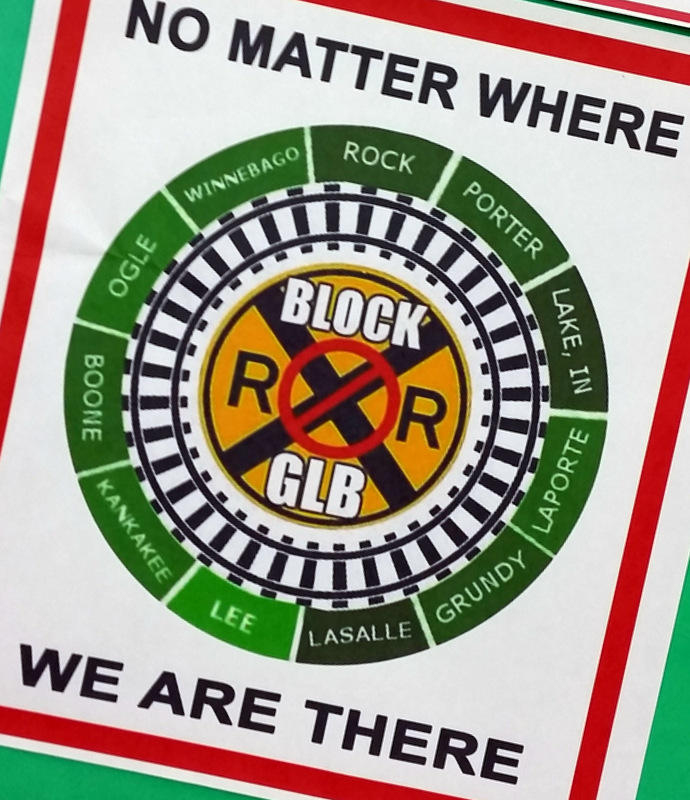
Anti-GLBR groups are unified.
Credit Susan Stephens / WNIJ
Oh, yes. Rock Against the Rail, Block GLB, RAILED, Citizens Against the GLB Railroad … Thousands of well-organized people have planted signs in their yards, called their Congressmen, shared endless amounts of information on social media and, most importantly, filed their comments objecting to the project with the Surface Transportation Board.
What’s that?
The STB is part of U.S. Department of Transportation. It’s in the process of preparing a review of the environmental impact of this project. It takes about two years. They’ve held public meetings and have gathered thousands of comments on their website from residents, businesses, organizations, and governments. The communications with the STB are available for everyone to see on their website.
What’s in it for the landowners?
They get $20,000 an acre, according to Patton. But you have to realize that their land would be purchased in strips 200 feet wide. So they’ll have to do some serious math to figure out how much they’d get for selling their land. (A strip that wide and not quite 220 feet long is an acre.) If they refuse to sell, there’s a chance they’d get a lot less for it after the legal process. In this region, land outside heavily populated areas is very often farmland, and farmers don’t appreciate being told their livelihoods are less important than others. That’s one reason that state Farm Bureaus object. Some farms would be bisected. Barb Beeler owns a farm near Beloit, Wisconsin, and has a little restaurant where she serves her farm-raised meats. The rail line is on track to cut through her farm, near the restaurant, cutting off access to pasture for some of her animals. She says she won’t be able to afford to feed them if that happens. Beeler says it’s frustrating not knowing for two years if she will have a train in her backyard.
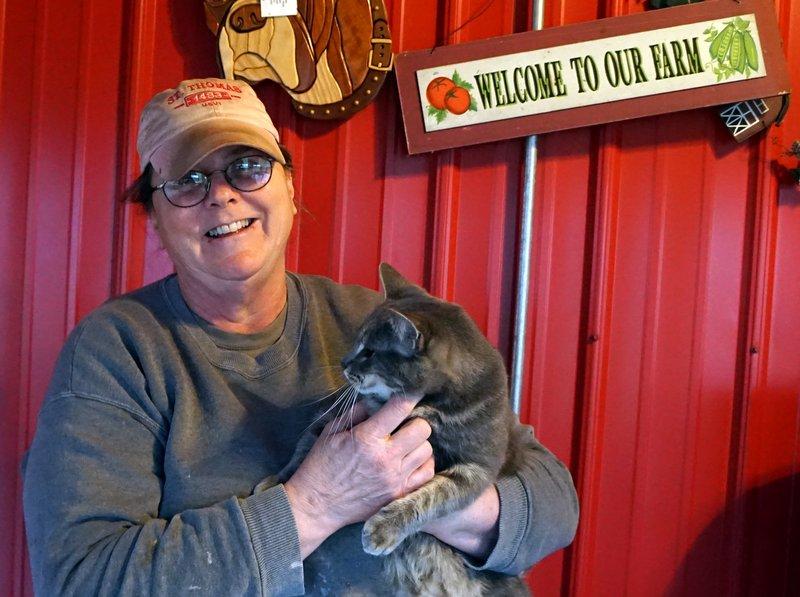
Barb Beeler and friend, at the Double B Cafe in Beloit
Credit Susan Stephens / WNIJ
As for landowners, Frank Patton has also promised free electricity to homeowners along the route and the potential for personal rail access, which might be appealing to businesses or very large farms.
Wait. Free electricity? How?
The company isn’t saying how or why, just that it will supply free electricity to the landowners and their immediate heirs, to one home on land connected to the right-of-way. As you can imagine, opponents are skeptical. And it also spurs speculation that the company wants these 200-foot-wide right-of-ways for more than a train: Opponents want to know if the land they sell will be used for other purposes, such as power lines or oil and gas pipelines.
Why not use existing rail lines? There are tracks everywhere around the region.
The company says using existing 19th century railroad beds would route their railroad through population centers, which defeats their purpose. There’s an alternative that opponents of this project point to: an organization called CREATE. It’s a coalition started in 2003 involving the U.S. and Illinois Departments of Transportation, the City of Chicago, regional passenger rail lines, and national freight rail companies. They are spending billions improving existing rail corridors and crossings to speed up freight and passenger rail. Supporters of the Great Lakes Basin Railroad say it will enhance CREATE’s efforts.
What’s next?
The public comment period ended in June, but the most recent route changes were announced in September: people can still send their comments to the Surface Transportation Board. The Board’s Office of Environmental Analysis is reviewing the project. Meanwhile, Great Lakes Basin Transportation wants to suspend the environmental review so it can focus on its entire application. They plan to file their application to build the railroad sometime next year and Patton has stated he wants to start building in 2018. Meanwhile, opponents are asking the government to hold more public meetings because of the route change.
Above is from: http://northernpublicradio.org/post/glbr-start-nowhere-near-finish
Railroad Will Need Eminent Domain Powers To Acquire Land
By Chase Cavanaugh • Dec 14, 2016
TweetShareGoogle+Email
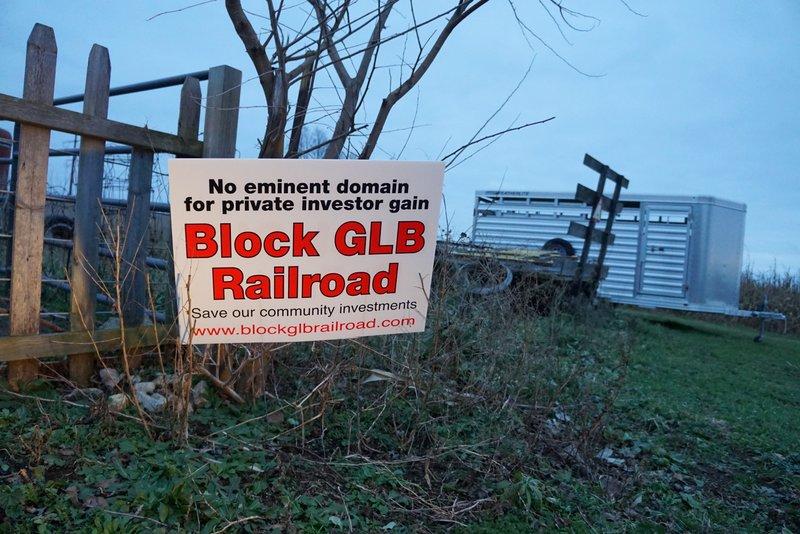
Susan Stephens/WNIJ
Before a company like Great Lakes Basin can build a railroad, it needs land. And since much of that land is privately owned, the firm needs a way to buy it.
How can a company like Great Lakes Basin Transportation convince people to sell their land when it's needed for their project?

Large transportation projects like railroads and interstate railways engender resistance from people whose land lies on its route. However, if they all refused to sell parts of their land, none of this infrastructure could get built. That's why governments and private companies make use of a legal procedure called eminent domain.
What is eminent domain?
The company in charge of the project (in this case, Great Lakes Basin Transportation Inc.) plans their route. Once the company has a definitive path, they'll have an idea of what land they need. This process would allow them to purchase the land they need outright.
What is the legal basis for this power, and how does a company obtain the privilege in Illinois?
The concept comes from the 5th Amendment to the U.S. Constitution. The final clause says private property can't be seized by the government unless "just compensation" is given to the owner. Traditionally, this is interpreted as the fair-market value of the land.
States have their own rules on who can make use of eminent domain. In Illinois, a list of these groups is maintained by the state government. Certain parties, such as the Department of Transportation, always have eminent domain authority, since it's essential for major road projects. However, entities that aren't on the list, such as GLBT, need to petition for the privilege on a case-by-case basis. If approved, the company has eminent domain authority for their specific project.
To whom does a private company need to petition for eminent domain rights?
Most parties need to send a proposal to the General Assembly. However, public utilities instead make their case to the Illinois Commerce Commission. There's an exception in the law for railroads, like the GLBR. These projects are pitched to the Surface Transportation Board, a regulatory body under the federal Department of Transportation.
What conditions must these projects meet to receive approval?

Charles Davidson is an MAI-designated real estate appraiser based in Rockford.
Charles Davidson is a Rockford-based real estate appraiser. He says projects need to meet three general conditions.
"The first one is they have to have the authority to actually condemn property," he says. "The second is they have to have a project for the public good, and the third is it has to be a necessary project."
What qualifies as "necessary?"
Davidson says the definition can vary.
"Some projects, especially road projects, have very obvious safety reasons. If they're going to reduce a hill or a blind spot that causes a lot of accidents, they might have to acquire land so they can lower the hill and spread it out."
However, more economically-oriented projects may have trouble meeting this condition. The Rock Island Clean Line is a project that would build transmission lines from Iowa through Whiteside, Henry, LaSalle, Bureau, and Grundy Counties. The project was approved by the Illinois Commerce Commission. However, an appellate court later ruled it didn't meet two conditions to qualify as a public utility. That case is being appealed to the Illinois Supreme Court. But even before the appellate ruling, the Commerce Commission had not granted eminent domain rights.
If the Great Lakes Basin Railroad is approved, how does the eminent domain process proceed?
The company would first send an appraiser like Davidson to examine the land. Similar to how real estate agents value open houses, he would compare neighbors' land to establish the local market price. His price would normally be close to that figure, but Illinois law specifically incorporates damage from a large project into the final property value.
“If you had a nice rectangular field, that’s very efficient to farm," Davidson says. "If you do a cut and put angles in that or make an irregular line, that makes it less efficient to farm and that creates a damage to the remainder. You can offset that with a special benefit to that property, but that’s all. They (the owners) always get paid for what’s taken.”
In a few cases, Davidson says it's even possible to improve the value of the property.
"If you’re going to buy some farmland right next to where a highway passes another highway and you’re going to put in an interchange, all of a sudden you can boost the value of that land significantly. In that case, obviously, the minimum you’re going to pay is zero, and you’re not going to hand a bill to the property owner."
Is the owner limited to the price they're quoted?
No. Davidson says once the property is appraised, they send out a negotiator, who has some wiggle room.
"The negotiator is not necessarily bound to that exact amount on the appraisal. He has some leeway, usually at least 10% without any problem," he explains. "And if the property owner can show that the appraiser has failed to recognize some element of compensation or value, then they may actually change it considerably or send the appraiser back to take a second look."
Can companies pay more than the appraised value?
Yes, and it's often to their advantage in terms of landowners' willingness to make the sale.
GLBR lawyer Mike Blaszak says the company intends to pay $20,000 per acre of farmland. He says that price "substantially exceeds the current fair market value if it were to be sold as farmland."
What does a company do if the owner won't make a sale?
They can initiate a legal process called "quick-take." Both the condemning authority (the legal term for the company with eminent domain rights) and the owner meet in court.
The company demonstrates they've gone through the appraisal process and that they can't reach an agreement. The property is deeded to the state, and money is put into an escrow account that the owner has access to. The amount is based on the property's appraised value.
At this point, however, Davidson says there is no decision on record.
"The condemning authority has title of the property," he explains. "They can continue with their project, but they continue to negotiate with the property owner, and if they really can't reach an agreement at some point, then it will actually go to trial."
Davidson says trials are uncommon (he says he was involved in 5 total out of more than a thousand quick-take cases). This is due to their expense, time commitment, and negative effect on both parties' relationship. The vast majority of quick-take cases end in a settlement.
Is eminent domain the same across state lines?
The overall process is the same (map out project, value property, make an offer, and use quick-take if necessary). However, the conditions companies need to meet when presenting their project differ. There may also be a distinction between public and private projects.
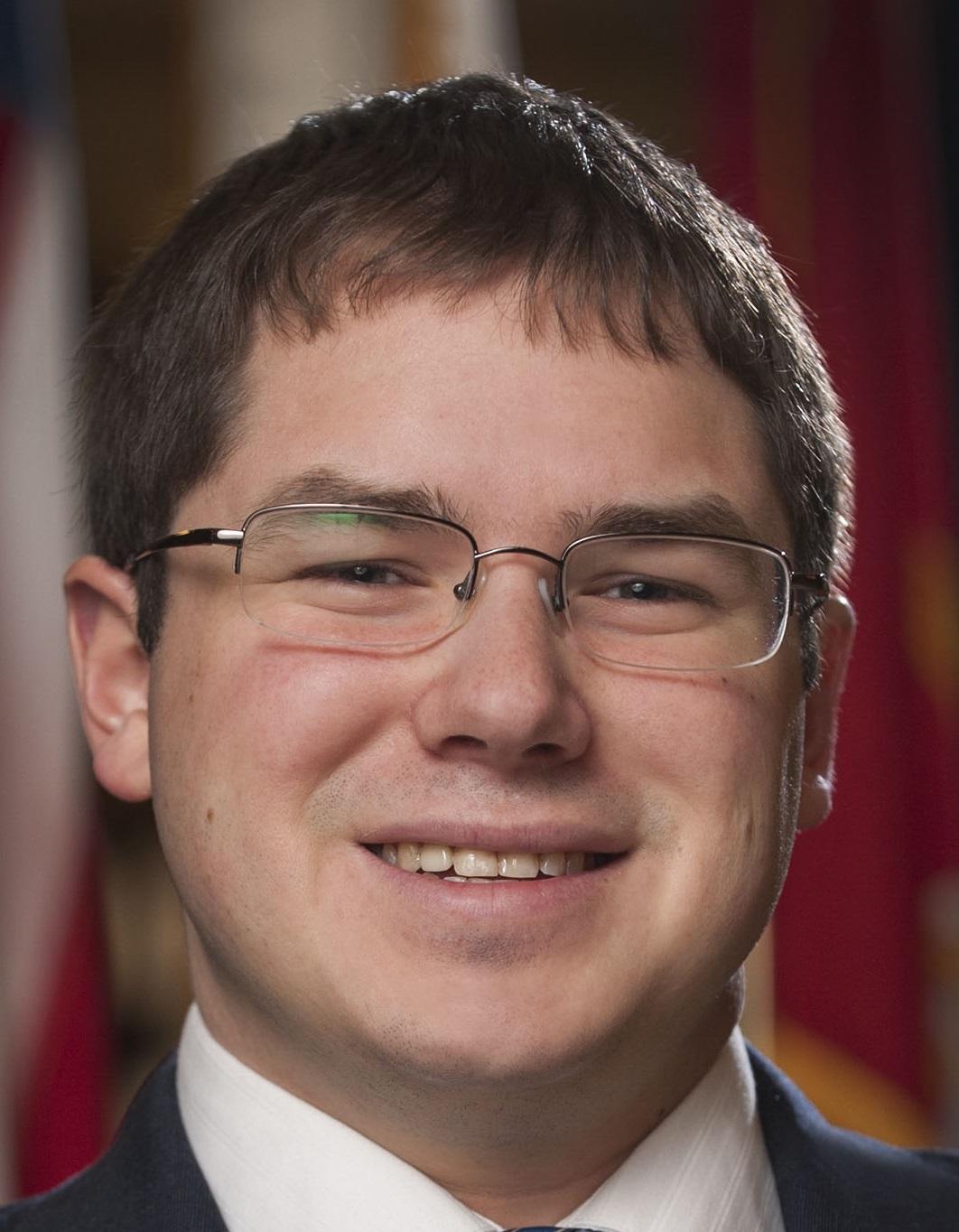
Mark Spreitzer represents the 45th District of the Wisconsin State Assembly.
Credit legis.wisconsin.gov
A couple of Beloit-area lawmakers are trying to put forward a proposal to remove Wisconsin eminent domain authority from private companies. State Rep. Mark Spreitzer says his constituents are concerned about businesses having this power, and he's trying to send that message to other lawmakers.
"And my message to them would certainly be that something like this could happen in their district and these laws were written way before anything like this was anticipated, way before people live in the kind of density that they do now."
Finally, when could the Great Lakes Basin Railroad start making use of eminent domain?
The Surface Transportation Board needs to finish reviewing the railroad's proposed route. Specifically it must draft an environmental impact statement. This details the various ways in which the railroad could impact the land through which it passes. Until the STB releases this statement and approves the proposed route or an alternative, GLBT cannot invoke eminent domain.
Above is from: http://northernpublicradio.org/post/railroad-will-need-eminent-domain-powers-acquire-land
Great Lakes Basin Railroad Factors In Geography, But Environmental Questions Remain
By Jenna Dooley • Dec 12, 2016
TweetShareGoogle+Email
![]()
Listen
Listening...
0:00
/
6:47
WNIJ's Jenna Dooley highlights some of the environmental questions surrounding the Great Lakes Basin Railroad project.
AMC's Hell on Wheels is a fictionalized version of the construction of the First Transcontinental Railroad across the Wild West in the 1860s.
The show draws much of its drama from a greedy tycoon who encourages workers to weave and wind tracks every which way to maximize profit—with little regard for the land.

Upon seeing a blueprint, self-proclaimed "villain" Thomas Durant laments, "Why have you made my road so straight?"
That is not so easy to get away with these days.
What type of geography is along the proposed route?
Mike Blaszak is a lawyer representing Great Lakes Basin Transportation, Inc. He says the plan is to avoid "hairpin" turns because a straight path allows the trains to reach higher speeds. Blaszak says great care has been taken to get the lay of the land.

This is a map of the current route proposal for the Great Lakes Basin Railroad.
Credit Great Lakes Basin Transportation, Inc.
"If somebody brought up that there was a feature that exists in the land that we weren't familiar with ... for example, I can think of one that was an old cemetery," Blaszak said. "It was an old cemetery that didn't do any marketing, but we found that there was one close to the route. We were able to adjust the route for that. We looked at river crossings. We are going to cross four major rivers. There will be four major bridges on the route. We are trying to select the river crossings that are the shortest and have the least environmental impact and make the most sense with respect to building the railroad."
How does the federal government come into this conversation?
The level of environmental scrutiny slows the process down considerably. Blaszak explains that there has to be an Environmental Impact Statement in order for the federal government to take any action on a requested permit.
Great Lakes Basin Transportation, Inc. is requesting a pause in that process, but Blaszak says he doesn't expect that will delay the overall timeline.
He says federal Surface Transportation Board members also have to approve construction in a separate process based on the law in which the potential transportation and financial impact are presented.
And when the Environmental Impact Statement is finalized, the board can act on the application and "approve" or "approve with conditions," or "reject" it. Blaszak says that could take another two years, but it is up to the Surface Transportation Board to create the precise timeline.
"When the STB acts, if it approves the railroad, then we would begin land acquisition and construction," Blaszak said.
What is the current impact of trains on the environment?
Mike Phillips, a geologist with Illinois Valley Community College in Oglesby, says a railroad of this scale can be a trade-off for the region.
"We already have a lot of trains going through the area. They go into Chicago, they get stalled in Chicago for traffic reasons," Phillips says. "While all the trains are sitting there, they are dripping on the railroad tracks a little bit, but more significantly, they're putting emissions into the air. That is unnecessary if they are just sitting there. One of the positives of this rail line is to keep the trains moving around Chicago, [which] means you are getting more distance per unit of pollution that you are putting out."
Geologically speaking, would the concern for the proposed route be for worst-case scenario instead of day-to-day issues?
Phillips says, "Just like if you are next to a highway, things drip off vehicles and things are going to drip off train engines. It is relatively small amounts. Things might fall out of railcars if they don't have perfect containment. Things drip out. Over time, that can be a concern. The other thing we look at is if there is a train accident. If a railcar -- or a set of railcars -- carrying oil, for example, have an accident, this certainly happens occasionally, what are their plans to deal with that?"
What other questions come to your mind?
"One of the kind of interesting things that I noticed when I looked at the pathway is, if you are familiar with northern Illinois history, there were a lot more railroad tracks in the past than we have today.
"In some places, you can see the pathway of this railroad coming close to where there used to be railroad tracks. In some ways, we are kind of building out what we tore down in the past. One notable exception to that is, if you look at where those old railroads went, they typically went through towns.
"They did that because they were part of our transportation system and also because the towns grew up around the railroads. This railroad tends to go around the towns, so they are trying to avoid major population centers. That feeds into what they want to do with the tracks.
"One of the questions that I have is, as they are going through here, what kind of care are they taking to avoid sensitive areas, environmentally speaking? One example would be wetlands. If you look at the maps, they are mapping out all the local wetlands. They are either going to have to avoid those or they will have to mitigate, which usually means creating a new wetland elsewhere to take the place of the one you damaged.
"The other thing that I am not aware of, but they are probably doing and should look at, is where are the wells for local towns? Are they making an effort to kind of avoid the area that collects water for those wells? We would call that the recharge area. You could determine a sensitive area around a public water supply well and then say, 'We really probably shouldn't have the railroad track going through that sensitive area.'"
How can stakeholders have a better idea of what's along the path?
One group keeping an eye on the land and water is the Rockford Metropolitan Agency for Planning.
That organization created maps which show an interconnected system of trails, parks and preserves, rivers, streams and lakes for Winnebago and Boone counties.

Credit RMAP
Executive Director Mike Dunn says people who live in communities along the proposed route can cross-check the proposed route with what they have identified along the line.
"Whether it is forest preserve, whether it's private farmland, whether it's watersheds, whether it's how this thing might pass a creek or a river, whether it's impact on homes — noise contours, sound contours, vibrations, how it is going to impact who might not have a home set on a farm but just along a county highway-- all those parties need to be considered."
Which means there are expected to be a lot more people at the table than when the Wild West was built.
Above is from: http://northernpublicradio.org/post/great-lakes-basin-railroad-factors-geography-environmental-questions-remain







 © Pablo Martinez Monsivais, AP In this Sept. 28, 2016, file photo, FBI Director James Comey testifies on Capitol Hill.
© Pablo Martinez Monsivais, AP In this Sept. 28, 2016, file photo, FBI Director James Comey testifies on Capitol Hill. 




